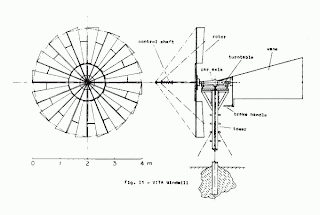It is a stationary, fire tube, internally fired boiler. The size is approximately from 7-9 meters in length and 2-3 meters in diameter.
Construction of Lancashire Boiler:
It consists of- Cylindrical shell
- Furnace tubes, bottom flue and side flues
- Grate
- Fire bridge
- Dampers
Cylindrical shell
It is placed in horizontal position over a brick work. It is partly filled up with water. The water level inside the shell is well above the furnace tubes.Furnace tubes, bottom flue and side flues:
Two large internal furnace tubes (flue tubes) extend from one end to the other end of the shell. The flues are built-up of ordinary brick lined with fire bricks. One bottom flue and two side flues are formed by brick setting, as shown in the figure.Grate
The grate is provided at the front end of the main flue tubes. Coal is fed to the grate through the fire hole.Fire bridge:
A brickwork fire bridge is provided at the end of the grate to prevent the flow of coal and ash particles into the interior of the furnace (flue) tubes. Otherwise the coal and ash particles carried with gases form deposits on the interior of the tubes and prevent the heat transfer to the water.Dampers:
Dampers is in the form of sliding doors are placed at the end of the side flues to control the flow of gases from side flues to the chimney flue.Working of Lancashire boiler
The hot gases, passing through the bottom flue, travel upto the front end of the boiler, where they divide into two streams and pass to the side flues. This makes the two sides of the boiler shell to become heated. Passing along the two side flues, the hot gases travel upto the back end of the boiler to the chimney flue. They are then discharged into the atmosphere through the chimney.
With the help of this arrangement of flow passages of hot gases, the bottom of the shell is first heated and then its sides. The heat is transferred to water through the surface of the two flue tubes (which remain in water) and bottom and sides of the shell.
The arrangement of flues increases the heating surface of the boiler to a large extent.
Dampers control the flow of hot gases and regulate the combustion rate as well as steam generation rate.
The boiler is fitted with necessary mountings. Pressure gauge and water level indicator provided at the front. Safety valve, steam stop valve, low water and high steam safety valve and man-hole are provided on the top of the shell.
High steam low water safety valve:
It is a combination of two valves. One is lever safety valve, which blows-off steam when the working pressure of steam exceeds. The second valve operates by blowing-off the steam when the water level falls below the normal level.Blow-off clock:
It is situated beneath the front portion of the shell for the removal of mud and sediments. It is also used to empty the water in the boiler during inspection.Fusible plug:
It is provided on the top of the main flues just above the grate. It prevents the overheating of the boiler tubes by extinguishing the fire when the water level falls below a particular level. A low water level alarm is mounted in the boiler to give a warning when the water level falls below the preset value.Salient features of Lancashire Boiler
The arrangement of flues in this boiler increases the heating surface of shell to a large extent.It is suitable where a large reserve of steam and hot water is needed.
Its maintenance is easy.
Superheated can be easily incorporated into the system at the end of the main flue tubes. Thus overall efficiency of the boiler can be increased.
Note : The simple vertical Boiler, Cochran and Lancashire Boilers discussed till this post are Fire tube boilers. In the upcoming posts, I will write about water tube boilers namely Babcock and Wilcox Boiler.























